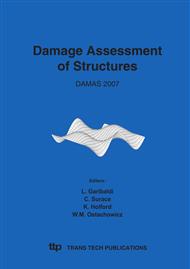p.447
p.455
p.461
p.467
p.473
p.479
p.487
p.493
p.499
Combining Cyclostationarity and the Frequency Domain Subspace Technique for Operational Modal Analysis
Abstract:
An underlying assumption of many operational modal analysis techniques is that the excitation is evenly distributed over the system, i.e. the inputs are spatially white, and is constant with frequency, i.e. frequentially white. This paper investigates the use of cyclostationarity, in combination with the Frequency Domain Subspace identification technique, to relax these constraints. Such a technique is suitable for application on systems which are excited by at least one cyclostationary input with a unique cyclic frequency, such as an internal combustion engine in a car or locomotive. The cyclostationary properties of this input are employed to reduce a multiple-inputmultiple- output system to a single-input-multiple-output system by extracting the component of each response measurement which is attributable to the cyclostationary input alone. The system modal properties; the resonances, damping and mode shapes, are then identified using the frequency domain subspace algorithm. The effectiveness of the technique is demonstrated through experiments on a laboratory test rig and a passenger train, and compared with results obtained using the knowledge of the inputs.
Info:
Periodical:
Pages:
473-478
Citation:
Online since:
September 2007
Authors:
Price:
Сopyright:
© 2007 Trans Tech Publications Ltd. All Rights Reserved
Share:
Citation:


